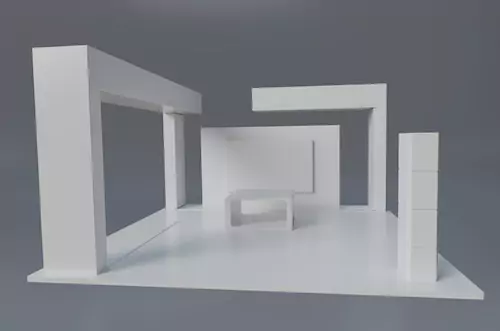If you’re trying to learn how to plan exhibitions, then you’ve reached the perfect article.
This article will answer it all for you.
From a checklist to considerations that no beginner will think about, this has it all.
We’ve compiled a list of popularly asked questions along with some expert tips and tricks.
Let’s get into it.
A. What are the three types of exhibitions?
We can broadly categorize exhibitions into three types:
- Art Exhibitions: They showcase artworks like paintings, sculptures, and photography. The target audience for such events is art enthusiasts and the general public.
- Trade Shows: They provide a platform for businesses to showcase their products or services, and generate leads. The target audience for these shows is industry professionals and potential clients
- Educational Exhibitions: They educate the public on a particular topic or issue. These are organized by educational institutions or non-profits. The target audience is students, teachers, researchers, and the general public
Each of these exhibitions has a different purpose, audience, and features.
Before learning how to plan exhibitions, you should learn all the types of exhibitions you can plan.
This crucial decision will guide you way better.

B. How to plan exhibitions?
What are the steps in planning such exhibitions?
1. Setting up exhibition goals
Define the purpose of organizing the exhibition and the target audience of your exhibition.
This will help you set goals better.
2. Know your subject
Have a clear idea of what you want to achieve. This will help in exhibition curation and marketing.
3. Creating a budget
Estimate the cost of venue, logistics, marketing, and staffing that will go into the exhibition event management.
Without budget estimation, you won’t know how to plan exhibitions.
Prepare a budget trying to keep the costs down.
Keep in mind all types of costs that may arise- rental, research, material, insurance, designing, installation, etc.
Ensure that your return on investment for the exhibition is accurate.
See where you are spending the most money and come up with plans to avoid the cost.
Refer to our event budget guide to get into the details of budget planning.
4. Finding potential sponsors
Along with the budget determine the sources of funding.
Create a financial plan and see if you can secure grants, sponsorships, or partnerships.
5. Selecting a venue
Choose a suitable venue for your exhibition based on the size, location, and facilities.
Consider the space required, budget, layout, theme, and facilities available.
Book your venue in advance and secure it to get your desired perfect space.
6. Layout designing
Perfect design and layout for your space are very important while planning the exhibition.
Distribute the focal points around the room, it draws people in different directions.
We will discuss this further in the next FAQ section, so make sure you read till the end.
7. Implementation
While organizing the exhibition formulate a detailed plan for the execution, setting up a timeline for each stage of setup.
Hire a team to manage the setup process.
The exhibition event management team should ensure that all the exhibits are installed according to the layout.
Maintain clear communication with the team members to prevent any problems or to address any issues
8. Staffing and recruitment
Recruit staff for roles such as guides, ticketing, and security.
Know in advance the number of staff required.
Prepare a list of roles and responsibilities. For example, a guide is expected to have good knowledge about the exhibition theme and concept from A to Z.
Provide training on their tasks and ensure they are experts in the exhibition content.
9. Marketing and promotion
To get an adequate return on investments, marketing is very important.
It’ll also be helpful in convincing artists and exhibitionists to agree to set up their stalls.
We will delve deeper into the subject of marketing while discussing how to plan exhibitions in the sections ahead.
For now, you can refer to our evergreen event marketing guide to get started.
10. Evaluation and follow-up
For a longer career in organizing exhibitions, you must evaluate your success and failure from the first event.
Ask yourself— What did I like? What did I dislike? Did I stick to my budget? Did I hit my goals? Where can I improve?
It’s also beneficial to take some sort of feedback from your attendees too
While these steps should teach you how to plan exhibitions in detail, you also need to know the things you might need.
This will help you plan your budget better and also come in handy when you’re cross-checking in the end.
C. What is an exhibition checklist?
If you’re learning how to plan exhibitions, look at these things you’ll absolutely need.

This list includes all the material and human resources one might need for organizing exhibitions:
- Event budget on Google Sheets that can be accessed by all stakeholders
- Defined target audience
- Marketing calendar with all posts, ads, and visuals
- Venue with designated spaces as per your exhibition layout
- Sales and leads targets
- Artwork or products for display
- USP of the event —What is the show-stopper? A product launch? Discounts? Free trials?
- Bright lights to enhance displays
- Utilities like water, electricity backup, and WiFi
- Furniture for seated events
- Cutlery if catering is part of the event
- Audio/visual equipment such as screens and speakers
- Extension boards (lots of these!)
- Dustbins to keep the exhibition tidy despite many attendees
- Insurance
- Security and medical personnel depending on the scale of the event
- Transportation and accommodation plans (if applicable) for VIPs
- ID cards (if required) to distinguish different exhibitors, staff, and visitors
- Freebies or promotional gifts
- Branded business cards
- Stationery such as cleaning materials, staplers, hole punchers, pens, scissors, tape measure, velcro, and cutters
- First-Aid box
D. Marketing strategy for exhibitions
You can’t learn how to plan exhibitions without cracking the code for marketing.
A marketing and promotion plan should be developed to attract visitors to your exhibition.
Keep your audience engaged with sneak peeks, behind-the-scenes, and interactive media campaigns.
The best way is to get your message out on all possible platforms. Refer to guides for these marketing channels:
The titles of promotions need to be to the point and should have meaning.
You also need to think about the photography, images, and posters you are going to use, that’s how people get an idea of what they are going to experience.
Your marketing budget should be your biggest consideration while planning the exhibition as marketing and advertising can be very costly.
E. How do I prepare for my first exhibition?
If this article has inspired you to wonder “How do I start my own exhibition?” then we must be doing something right.

The first thoughts you should be having are:
- Why am I planning this event?
- How can I source art or displays for my exhibition?
- What is my budget without any funding?
- Do I have enough manpower to organize an exhibition?
- Is there a venue that’s affordable or free for me?
By answering these questions, you’ll clear your head.
From there, you can refer to our step-by-step guide above to take it forward.
Professional Tip: Use inexpensive white-labeled event tickets to make your event more formal.
F. How to make an exhibition successful?
Planning a successful exhibition is an art that requires attention to detail. Every element, from the right venue to an engaging layout plays a very crucial role.
Here are some small details that can significantly enhance your exhibition:
1. Switch things up
Keep your exhibition flexible. Redesign every eight to ten weeks according to different exhibition themes.
Jon Benington, a gallery manager says— “to change the look and feel of the exhibition we sometimes change the wall color, and screens on wheels that can be moved around. It is important to take into consideration what the visitors would experience. Visitors respond to the mood and atmosphere of the exhibition” [source: Victoria Art Gallery]
2. Put the audience first
Taking into account the audience’s needs is the golden rule which must be prioritized.
You can work on what type of audience you want to attract and can build up that audience for yourself.
The Victoria Art Gallery exhibition considered its younger audience in several ways, including hanging the pictures lower and having an activity space [source: Victoria Art Gallery].
3. Labeling the right way
Some exhibitions can make the attendees feel clueless.
Don’t expect them to know all displays the way you day.
While writing the labels consider what you want the visitors to learn from the labels.
A label of more than a hundred words is not want you would want to have.
Put up labels with short sentences, and simple English, keeping it relevant. What you write should explain what people are looking at.
4. An exhibition is more than just displays
Various activities and engaging tasks should be thought of while planning an exhibition.
Activities give people an extra reason to visit exhibitions.
John Mclay the ‘Here Be Dragons’ curator says—“There should be something physical and practical that they can do to spend time in the space along with the visuals.”
It should be related to whatever the exhibition is about.
A gallery gift shop can be a part of the visitor’s experience, linking the visitors and the exhibition experience.
5. An overrated but important advice
Prepare in advance!
The more preparation you do in advance the less pressure you’ll face while putting the work into display.
G. FAQ
1. How do I find a theme for exhibitions?
Learning how to plan exhibitions will be in vain if you don’t learn the article of storytelling.
The best way to tell stories in exhibitions is by having a theme.
Research and develop a theme that aligns with your purpose. Think of whether it will excite your target audience. Decide the type of exhibits to be presented accordingly.
The Victoria Art Gallery has an exhibition advisory panel for coming up with exhibition ideas.
Rebecca Clay, a member of the advisory panel says—“We get to hear all the different exhibitions that are put forward and then we tell whether we think that it’s going to be popular or not” [source: Victoria Art Gallery]
2. How do you plan an exhibition layout?
Since you’re learning how to plan exhibitions, you must learn how to guide people’s attention.

With the right lighting and placement of different displays, you can control where people look and for how long.
The layout depends on the space that you are exhibiting in and what the event manager is trying to express to its visitors. The Victoria Art Gallery exhibition explored a painter’s travels and the art was grouped by location to aid the theme.
Jon Benington, the gallery manager sayș—“There is always a story one is trying to tell through the exhibition and its narrative dictates the order in which the works are displayed. It is done chronologically and by theme. The audience likes to have a story and follow a narrative, achieving that in your layout makes a better exhibition.”
H. Conclusion
We hope this article was instrumental in your baby steps toward learning how to plan exhibitions.
Don’t forget to leave your expert opinions in the comments below so others can learn from your expertise.
We at EventTube, don’t just educate people on how to plan exhibitions but all kinds of events.
For the latest event industry updates and event planning guides, join our exclusive community below.







